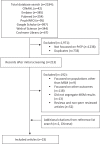Awareness and willingness to use HIV pre-exposure prophylaxis among men who have sex with men in low- and middle-income countries: a systematic review and meta-analysis
- PMID: 28691439
- PMCID: PMC5515024
- DOI: 10.7448/IAS.20.1.21580
Awareness and willingness to use HIV pre-exposure prophylaxis among men who have sex with men in low- and middle-income countries: a systematic review and meta-analysis
Abstract
Introduction: To facilitate provision of pre-exposure prophylaxis (PrEP) in low- and middle-income countries (LMIC), a better understanding of potential demand and user preferences is required. This review assessed awareness and willingness to use oral PrEP among men who have sex with men (MSM) in LMIC.
Methods: Electronic literature search of Cochrane library, Embase, PubMed, PsychINFO, CINHAL, Web of Science, and Google Scholar was conducted between July and September 2016. Reference lists of relevant studies were searched, and three authors contacted for additional data. Non-peer reviewed publications were excluded. Studies were screened for inclusion, and relevant data abstracted, assessed for bias, and synthesized.
Results: In total, 2186 records were identified, of which 23 studies involving 14,040 MSM from LMIC were included. The proportion of MSM who were aware of PrEP was low at 29.7% (95% CI: 16.9-44.3). However, the proportion willing to use PrEP was higher, at 64.4% (95% CI: 53.3-74.8). Proportions of MSM aware of PrEP was <50% in 11 studies and 50-70% in 3 studies, while willingness to use PrEP was <50% in 6 studies, 50-70% in 9 studies, and over 80% in 5 studies. Several factors affected willingness to use PrEP. At the individual domain, poor knowledge of PrEP, doubts about its effectiveness, fear of side effects, low perception of HIV risk, and the need to adhere or take medicines frequently reduced willingness to use PrEP, while PrEP education and motivation to maintain good health were facilitators of potential use. Demographic factors (education, age, and migration) influenced both awareness and willingness to use PrEP, but their effects were not consistent across studies. At the social domain, anticipated stigma from peers, partners, and family members related to sexual orientation, PrEP, or HIV status were barriers to potential use of PrEP, while partner, peer, and family support were facilitators of potential use. At the structural domain, concerns regarding attitudes of healthcare providers, quality assurance, data protection, and cost were determinants of potential use.
Conclusions: This review found that despite low levels of awareness of PrEP, MSM in LMIC are willing to use it if they are supported appropriately to deal with a range of individual, social, and structural barriers.
Keywords: HIV; low and middle income countries; men who have sex with men (MSM); pre-exposure prophylaxis (PrEP); systematic review.
Conflict of interest statement
The authors have no competing interests to declare.
Figures





References
-
- Murray CJ, Barber RM, Foreman KJ, Abbasoglu Ozgoren A, Abd-Allah F, Abera SF, et al. Global, regional, and national disability-adjusted life years (DALYs) for 306 diseases and injuries and healthy life expectancy (HALE) for 188 countries, 1990-2013: quantifying the epidemiological transition. Lancet. 2015;386(10009):2145–27. doi: 10.1016/s0140-6736(15)61340-x - DOI - PMC - PubMed
-
- UNAIDS Global AIDS update, 2016. Geneva: UNAIDS; 2016.
-
- WHO Guidance on Pre-Exposure Oral Prophylaxis (PrEP) for serodiscordant couples, men and transgender women who have sex with men at high risk of HIV. Recommendations for use in the context of demonstration projects. Geneva: World Health Organization; 2012. - PubMed
-
- WHO Guideline on when to start antiretroviral therapy and on pre-exposure prophylaxis for HIV. Guideline on when to start antiretroviral therapy and on pre-exposure prophylaxis for HIV. Geneva: World Health Organization; 2015. - PubMed
Publication types
MeSH terms
Substances
Grants and funding
LinkOut - more resources
Full Text Sources
Other Literature Sources
Medical
Miscellaneous

